What is AIS and How to Download It
Rounaq Neroy
Jun 25, 2024 / Reading Time: Approx. 10 mins
Last week, I explained what is Form 26AS and how to download it for the purpose of filing your Income Tax Return.
But Form 26AS, which is the annual tax statement capturing the details of Tax Deducted at Source (TDS) and Tax Collected at Source (TCS) in the financial year, will not suffice to file your ITR. You also need the Annual Information Statement (AIS) along with the other necessary documents.
What is an Annual Information Statement or AIS?
In simple terms, the Annual Information Statement or AIS, introduced in November 2021, is an extension of Form 26AS.
The AIS provides a comprehensive view of information for a taxpayer displayed in Form 26AS.
So other than the TDS and TCS details, the information relating to your specified financial transactions, such as the following is contained in the Annual Information Statement or AIS:
-
- Income from salary
-
- Income from business or profession
-
- Rent received
-
- Dividends from investment in shares
-
- Interest earned on deposits
-
- Interest on bonds/government securities
-
- Foreign currency bond/share income u/s 115AC
-
- The accumulated balance in the Provident Fund (PF) account
-
- Gains from sources like lottery, horse races, crossword puzzles, online games, etc.
-
- Purchase and sale of securities
-
- Offshore fund income/long-term capital gain u/s 115AB(1)(b)
-
- Purchase & sale of immoveable properties
-
- Sale of vehicle
-
- Purchase of vehicle
-
- Off-market debit and credit transactions
-
- Insurance commissions
-
- Life insurance policy receipts
-
- Withdrawals from National Savings Scheme (NSS)
-
- Specified senior citizen income
-
- Remittances under Liberalised Remittance Scheme (LRS)
-
- Purchase of foreign currency
-
- Expenses on foreign travel
-
- The information regarding advance tax/self-assessment tax
-
- Cash deposit and payments
-
- GST purchases and turnover
-
- Virtual digital asset transfer receipts
-
- Details of tax refund
-
- TDS defaults (if any)
-
- Information relating to pending and completed proceedings, which were earlier available in Form 26AS
Watch this video to know about AIS and how to download it.
The aforementioned information is displayed in Part B of the AIS, whereas Part A comprises the general information such as your, the taxpayer/assessee's name, PAN, Aadhar, date of birth, address of the taxpayer, registered mobile number and email address.
Further, the aggregation of transactions on the information source level is also encapsulated in the Taxpayer Information Summary (TIS). The TIS for the respective sources of income, such as salary, business or profession, rent, dividend, interest on deposits, purchase & sale of securities, purchase & sale of immoveable properties, outwards remittance under LRS, etc. and shows the amount reported by the source, processed by the system, and accepted by the taxpayer/assessee.
The information accepted by the taxpayer/assessee in the TIS is used for the pre-filling of the ITR.
It is also possible for you, the taxpayer/assessee to track the activity history in AIS by clicking on the 'Activity History' button on the AIS homepage.
The objective of the AIS is:
-
- To display complete information to you, the taxpayer/assessee regarding your financial transactions in the respective assessment (applicable to the financial year)
-
- Prevent non-compliances
-
- Promote voluntary compliance and enable seamless pre-filling of ITR
How to View and Download Annual Information Statement or AIS?
To view and download the Annual Information Statement or AIS, here are the steps to follow:
Step #1: Login to the income-tax e-filing portal using your PAN or Aadhaar - https://eportal.incometax.gov.in/iec/foservices/#/login
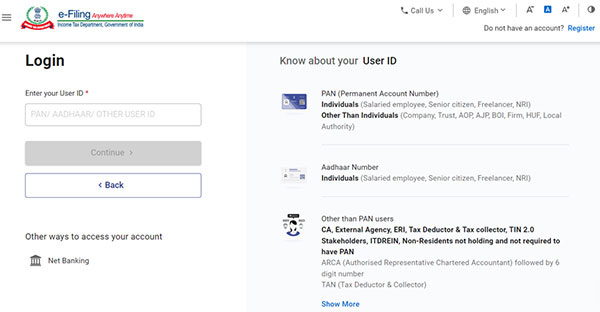
Step #2: Once you enter the Aadhaar number or PAN, enter the password (In case you do not remember your password, you can reset it, or you could log in using a One-Time Password (OTP) sent on the mobile number registered with Aadhaar).
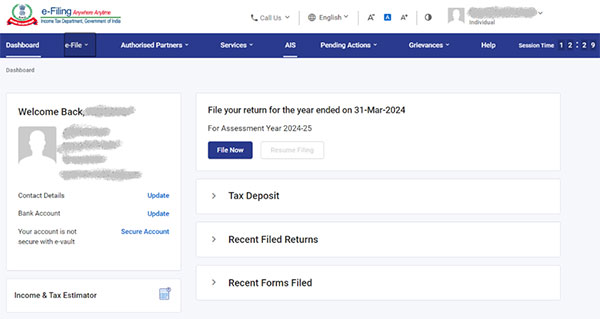
Step #3: After you login, click on the AIS tab and click on the proceed button on the pop-up.
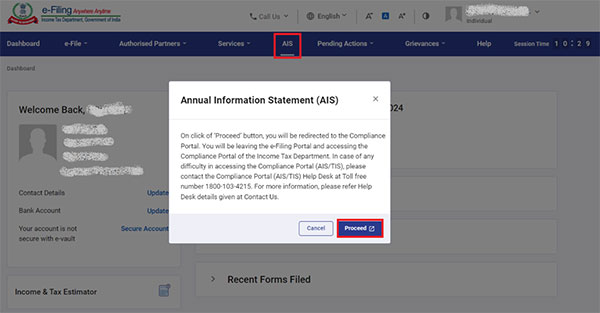
Step #4: On the next page screen, click on 'AIS'.
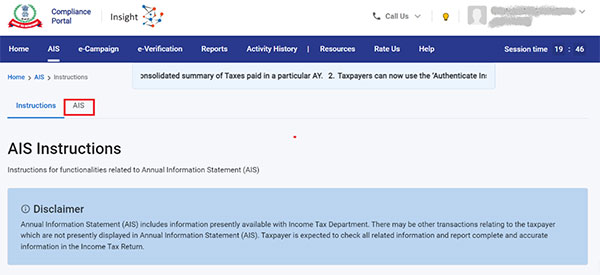
Step #5: On following step 4, by clicking on TIS and/or AIS on the next page/screen you will be able to view them.
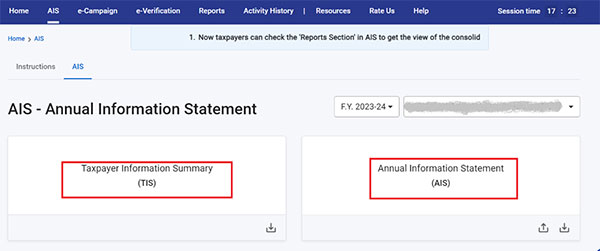
The TIS can be downloaded in a PDF format, while the AIS in PDF, JSON, or CSV file formats.
Note, that the PDF will be password-protected. To open the file, you will need to enter the combination of the PAN (in lower case) and the date of birth in case of an individual taxpayer/assessee (or date of incorporation/formation for the non-individual taxpayer) in the format ddmmyyyy without any space. For example, if the PAN is AAAAA1234A and the date of birth is 21st January 1991 then your password will be aaaaa1234a21011991.
Can errors in the Annual Information Statement or AIS be rectified?
As a taxpayer or assessee, if you find any errors in AIS, you can provide feedback to the Income Tax department (on the online portal) to get it corrected, i.e. rectified.
The feedback on the active information displayed under the TDS/TCS, SFT (Specified Financial Transactions), entries or other information can be provided by following the below three easy steps:
Step #1: Click on the optional button mentioned in the feedback column.
Step #2: From the dropdown menu, choose the relevant Choose the relevant feedback option and enter the feedback details (dependent on the feedback option).
Step #3: Click on the 'submit' button to submit your feedback.
The Central Board of Direct Taxes (CBDT) has rolled out a new functionality from May 13, 2024, that displays the status of AIS correction or feedback of the taxpayer/assessee.
Thus, now upon submission of your feedback on the AIS information, the feedback will be displayed with the information.
It will display whether the feedback or correction from the taxpayer/assessee has been accepted partially, fully or rejected by the source (i.e. person responsible for uploading information in AIS).
The AIS shall reflect then reflect both, the reported value, and the modified value (i.e. after considering your feedback as taxpayer/assessee). Moreover, an email and SMS confirmations for submission of feedback will also be sent. The activity history tab will also be updated, and you will be able to download the acknowledgement receipt.
Currently, there is no limit on the number of times you can modify the previously given feedback. The taxpayer/assessee is also given the option to view all your AIS feedback in one place, under the AIS Consolidated Feedback file (ACF), which is also available in a downloadable PDF format for easy understanding.
To conclude…
Keep in mind that much of the pre-filling in the ITR is from TIS (summarisation of AIS) and Form 26AS. For all its analysis and verification, the IT department uses these important documents. The Income Tax department has observed higher numbers of cases of mismatch in AIS and ITR. The mismatch could result in underreporting of income and thus review your AIS thoroughly.
It is important that the AIS, TIS and Form 26AS carry correct and true information so that mistakes are avoided when filing your ITR, which could cost you tax penalties, interest thereon, and notices later.
File your ITR with true and correct information for a seamless and hassle-free tax filing experience. As a law-abiding citizen, make it a point to file your ITR well before the due date and discharge your moral and constitutional responsibility.
"In this world, nothing is certain but death and taxes." - Benjamin Franklin.
Join Now: PersonalFN is now on Telegram. Join FREE Today to get PersonalFN’s newsletter ‘Daily Wealth Letter’ and Exclusive Updates on Mutual Funds.
-New.png)
ROUNAQ NEROY heads the content activity at PersonalFN and is the Chief Editor of PersonalFN’s newsletter, The Daily Wealth Letter.
As the co-editor of premium services, viz. Investment Ideas Note, the Multi-Asset Corner Report, and the Retire Rich Report; Rounaq brings forth potentially the best investment ideas and opportunities to help investors plan for a happy and blissful financial future.
He has also authored and been the voice of PersonalFN’s e-learning course -- which aims at helping investors become their own financial planners. Besides, he actively contributes to a variety of issues of Money Simplified, PersonalFN’s e-guides in the endeavour and passion to educate investors.
He is a post-graduate in commerce (M. Com), with an MBA in Finance, and a gold medallist in Certificate Programme in Capital Market (from BSE Training Institute in association with JBIMS). Rounaq holds over 18+ years of experience in the financial services industry.
Disclaimer: This article is for information purposes only and is not meant to influence your investment decisions. It should not be treated as a mutual fund recommendation or advice to make an investment decision in the above-mentioned schemes. Use of this information is at the user's own risk. The user must make his own investment decisions based on his specific investment objective and financial position and use such independent advisors as he believes necessary.